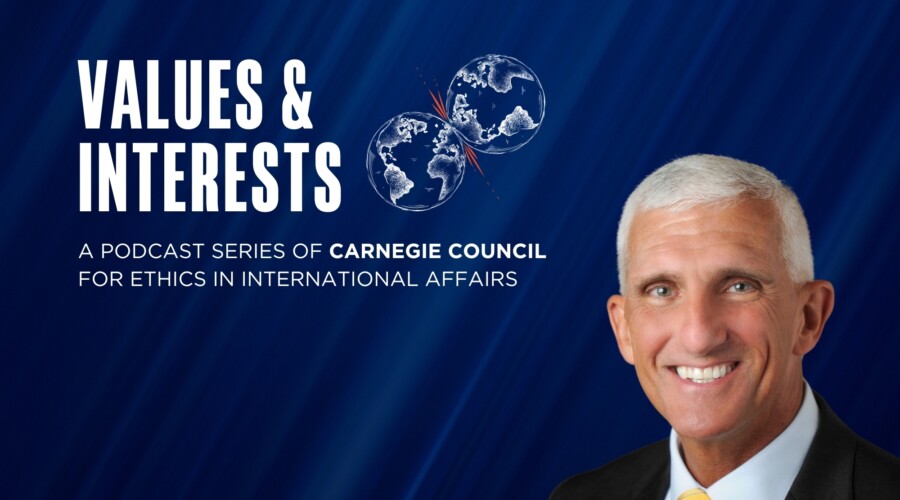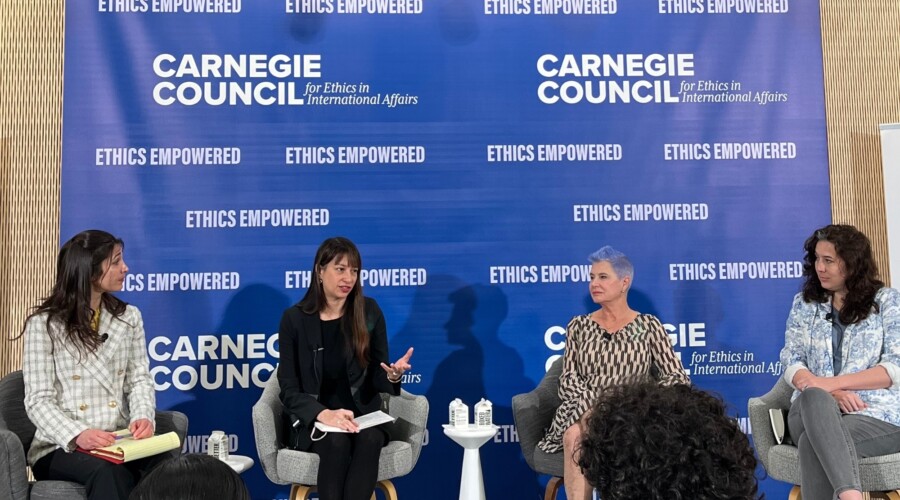Atomic energy can be split into two issues: the proliferation of nuclear weapons technologies, and the spread of peaceful nuclear power for electricity generation.
Both were hot topics late last week when Iranian nuclear negotiator Ali Larijani pledged that his country would begin to fill in suspicious gaps in its atomic history. Without such information it is difficult for the International Atomic Energy Agency to certify that Iran has peaceful intentions, a key determiner in the imposition of sanctions. Iran has yet to halt its current uranium enrichment program, a concession sought by the international community.
Under the 1968 Treaty on the Non-Proliferation of Nuclear Weapons (NPT), non-nuclear states have an "inalienable right" to develop nuclear power for peaceful use. The NPT also states that signing members desire "to achieve at the earliest possible date the cessation of the nuclear arms race and to undertake effective measures in the direction of nuclear disarmament." It seems these charged ideas were on a collision course from the start.
Nuclear energy was first developed in the United States in the 1950s and used by the U.S. Navy to power submarines. Commercial use expanded in the late 1950s and 60s. Today, about 20 percent of U.S. electricity comes from nuclear power. 436 nuclear power plants are operating worldwide, providing 16 percent of the world's electricity for 30 countries. Thirty-one additional plants are under construction.
Energy diversification has risen to the top of policy agendas as scientists, governments, and individuals increasingly accept the human contribution to climate change. The main cause of global warming is greenhouse gas emissions from the burning of fossil fuels, whereas nuclear energy is practically emission-free.
Even consistent anti-proliferation organizations and individuals have begun to reexamine their stances on nuclear energy because of the climate issue. Greenpeace founder Patrick Moore is optimistic that "nuclear energy may just be the energy source that can save our planet from disaster: catastrophic climate change." Nuclear energy was also under discussion at the UN Commission on Sustainable Development's 15th session last month.
Producing electricity from nuclear fuel creates less carbon dioxide per kilowatt-hour than does energy from coal, gas, hydroelectric, wind, or solar. According to the Nuclear Energy Institute, "The energy in one uranium fuel pellet—the size of the tip of your little finger—is the equivalent of 17,000 cubic feet of natural gas, 1,780 pounds of coal, or 149 gallons of oil."
But these environmental benefits may be overshadowed by nuclear energy's other risks. Some argue that having more nuclear power plants increases the chance of an accident. The IAEA contends, however, that the infamous accidents at Three Mile Island and Chernobyl led to the development of a "truly international nuclear safety regime" that makes accidents unlikely.
The energy in one uranium fuel pellet—the size of the tip of your little finger—is the equivalent of 17,000 cubic feet of natural gas, 1,780 pounds of coal, or 149 gallons of oil.
Another criticism is that more nuclear power plants means more radioactive waste. There is no set international protocol for dealing with nuclear waste. Some countries store spent nuclear fuel; others directly dispose of it. Still others recycle the fuel, circumventing the problem of large plutonium storage facilities or mines that might be accessed by terrorists. This last method is not as cost effective as the first two and is not widely practiced.
Another worry is the effect of radiation exposure on the public, especially those living near power plants. Surprisingly, the radiation exposure from living within 50 miles of a nuclear power plant is one one-thousandth the average dose Americans receive from X-rays and other medical procedures. Most radiation we experience comes from natural sources, such as substances in the air, in food and water, and from the Earth itself. The exposure to radiation from living with a home smoke detector is comparable to someone living within 50 miles of a nuclear power plant.
According to Alan McDonald, a senior officer in the IAEA Department of Nuclear Energy, countries must do their own cost-benefit analysis when deciding whether or not nuclear energy is desirable. Influential factors include whether alternatives are available, electricity demand and demand growth, and the overall market structure and investment environment, including subsidies and carbon pricing through cap and trade.
Next, a country must take into account regulatory risks and international safety and approval measures. Last, the public's preferences will likely have an effect. McDonald concludes: "New nuclear power plants are most attractive where energy demand growth is rapid, alternative resources are scarce, energy supply security is a priority or reducing air pollution…is mandated." Currently, these factors are most applicable to Asia.
McDonald also stresses that nuclear energy is not a perfect solution for global warming and rising energy prices. He advises that alternatives, such as solar and wind power, should be pursued alongside nuclear power.
Those relying too heavily on nuclear power may encounter unique environmental problems. Although nuclear energy releases minimal greenhouse gases into the atmosphere, it requires a lot of water for the cooling process. Most plants are built near oceans, rivers, and lakes, where the water is used for cooling. But rising temperatures due to global warming hampers this process. During the summer 2003 heat wave in Europe, France shut down or reduced the capacity of 17 of its reactors. France relies on nuclear power for more than half of its electricity.
What happens when a country developing nuclear power does not conform to international agreements and safety measures?
The spread of nuclear technology for energy purposes begs a question: What happens when a country developing nuclear power does not conform to international agreements and safety measures? This is exactly the problem that the IAEA and the international community face today with Iran. The UN has passed two resolutions (1737 and 1747) against Iran's enrichment of uranium because it is not convinced the program is benign.
Uranium enrichment is required on a low scale for energy production and on an industrial scale for weapons production. At a celebratory ceremony held at the nuclear facility at Natanz, on April 9, President Mahmoud Ahmadinejad announced that Iran "is among the countries of the world that produces fuel on an industrial scale," and "this nuclear fuel is definitely for the development of Iran and expansion of peace in the world."
Ahmadinejad's claim cannot be independently verified. In response to a March 24 UN resolution, Iran announced that it would cease cooperating with the IAEA in key respects, including the provision of advance information on the design of new facilities capable of producing nuclear fuel.
The United States and Russia have been at odds on this issue due to Russian support for Iran's nuclear infrastructure. In February, Russian officials said that the government would withhold nuclear fuel from Iran due to non-payment for construction of a nuclear power plant at Bushehr. The facility could provide about 4 percent of Iran's total electricity, or enough plutonium to construct 35 nuclear weapons per year.
A statement by Iran's National Security Council Secretary may signal a change in Iran's relations with Russia. Iran says it does not want to rely on Russia for the enrichment of its uranium. Meanwhile, Russia has called upon Iran to cooperate with the UN and IAEA in order to open up negotiations.
Despite this shift, things are still rocky between the United States and Russia. The U.S. military recently visited the Czech Republic military base that is poised to become part of missile-defense system designed to protect the United States and its allies against possible Iranian nuclear attacks. Russian President Putin has opposed the use of any kind of anti-missile system on the grounds that it would disrupt the global balance of power based upon first-strike capability.
Russia occupies an interesting position in the nuclear energy debate. In the past few years, it has committed to expanding its nuclear energy infrastructure with the construction of more power plants. Due to its long history of handling nuclear material, Russia has also become a world commercial supplier of nuclear-fuel-related services, including recycling.
At the same time, however, Russia relies on revenue from energy sources such as oil and natural gas, which account for 55 percent of all exports. This means world energy prices and Middle East stability have an important effect on Russian economic growth.
It's likely that the construction of nuclear power plants will continue, particularly where states have the funds and incentives to do so, and no fear of flirting with the fine line between nuclear energy and nuclear weapons.
Related Materials:
AUDIO: Nuclear Proliferation: A Delicate Balance Between Force and Diplomacy, Joseph Cirincione (Carnegie Council, December 2006).
Mirage and Oasis: Energy choices in an age of global warming, Andrew Simms, Petra Kjell, David Woodward (New Economics Foundation, June 2005).
AUDIO: Are We Misreading Iran's Nuclear Politics? Vali Nasr, Fatemeh Haghighatjoo, John Tirman (Carnegie Council, May 2006)
Nuclear Terrorism: The Ultimate Preventable Catastrophe, Graham Allison (Carnegie Council, November 2004).




